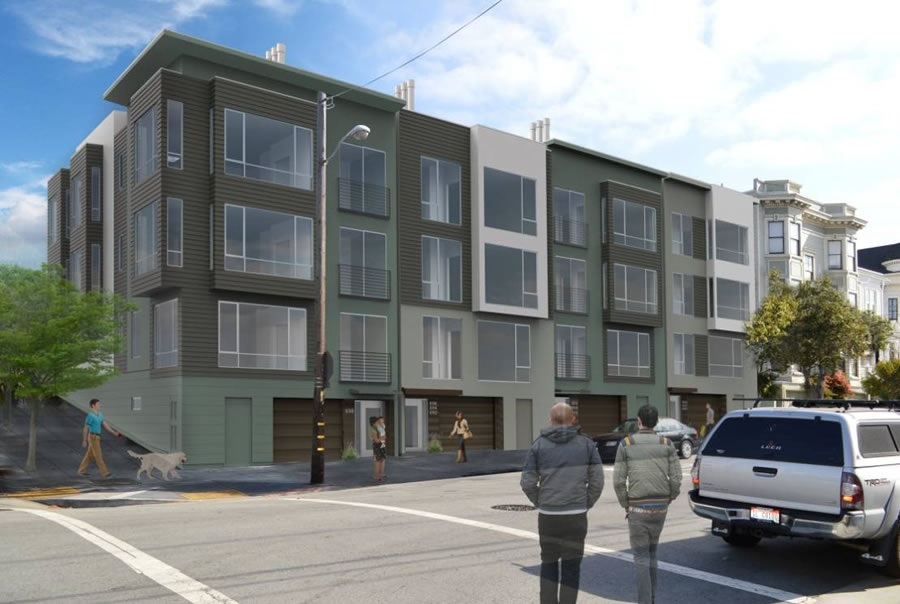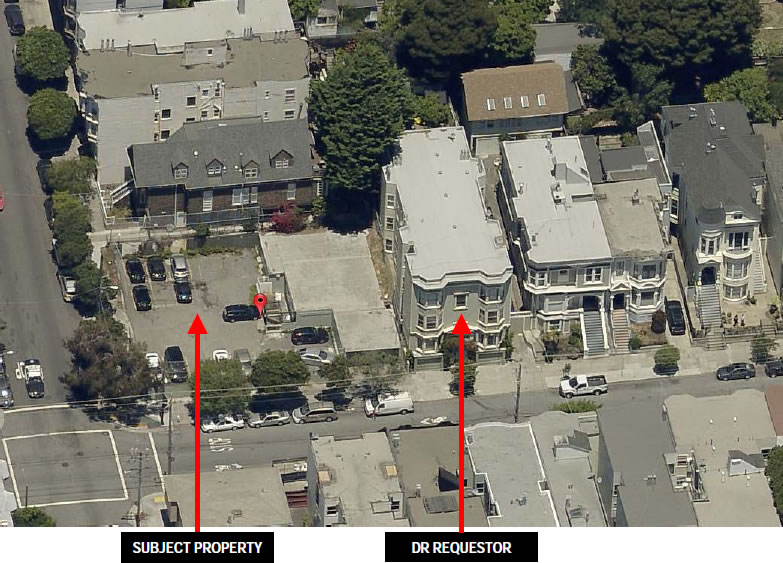The designs for the proposed development to be built on the northeast corner of Page and Steiner, with four new four-story buildings to rise on the site of the bunker-like former church and community center at 690 Page Street, have been challenged by a resident in the six-unit condo building next door.
Concerned that the development will result in the loss of light and privacy and an increase in noise, the requestor of the Discretionary Review (DR) would like the developer to eliminate one of the four buildings from their plans and reconfigure the entire development to front Steiner instead of Page, allowing for more separation between the buildings and for the proposed roof decks to be moved further away from their windows and line of sight.
Noting that the proposed project meets all applicable requirements of the Planning Code, would create 12 new three-bedroom units, and is “consistent with the size and density of the immediate neighborhood,” San Francisco’s Planning Department is recommending that the Planning Commission approve the project as proposed.
Also noted by the Planning Department, the project meets the standards of the Residential Design Guidelines and “would not be considered exceptional or extraordinary” per the Residential Design Team’s review. And while that further supports the project being approved, one could wonder if it should.


Three bedroom condos are very much in demand for families. These twelve units will be great for keeping families in the City. I do see a reduction in street parking on Page Street for the four new driveways. Are the codes different for three bedroom units when it comes to building parking? Will each unit get a car parking space?
The development would have a parking space for each unit. I wish project had one consolidated garage so there’d be need for only one curb cut instead of four.
I absolutely agree; given the scarcity of parking, the City really should be pushing developers to limit curb cuts.
Curb cut restrictions are in Planning Code 155(r).
I don’t think this block of Page Street is covered in this restriction.
The city should offer some sort of incentive for people to return curb cuts in front of unused garages to the public.
Chris – That is a great point.
We have got to get rid of the ability of 3rd parties to stymie projects that otherwise conform to code. Nothing will turn a leftie to a conservative faster than trying to address property issues in San Francisco. How in heck should a neighbor have any say over a legal, conforming action – whether it’s a complete development such as this, let alone something minor like putting on a rear deck?
we need “as of right” construction like NYC. does it comply with all existing codes, zoning, and regulations? here’s your permit.
Sierrajeff…. take a breath. They are recommending approval.
The point is that there should be no challenge allowed at all for a project that meets current standards.
exactly. I thought it was clear that I was speaking of the neighbor challenging the project, not the planners who are set to approve it…
Even if the ‘fair outcome’ is achieved, allowing the DR process to add months to approvals of a project like this is frustrating and contributes to more expensive housing for everyone.
We have a nice city in part because we have so many people ‘invested’ emotionally in our neighborhoods, but creating a process that allows anyone to trip up a project for very self-interested reasons is difficult.
I would argue that there should be a single Discretionary Review period possible for any one project. The real bear is that the [neighbor] can submit another DR request if (when) this review request gets shot down. That’s too much.
One simple solution would be to set very high Discretionary Review fees to discourage frivolous DRs. Most people would probably think twice before submitting a DR application for projects like this which are completely within zoning compliance.
Don’t raise the DR fees beyond what is required to administer the program. If that’s still not enough to discourage frivolous DRs then add a requirement that if the DR fails that the requester must compensate the developer for some if not all of the costs added by the DR delay. Legitimate DRs would still be safe. Annoyance DRs would be drastically cut back.
I agree with soccermom we need to change the DR process in SF!
Why does this building (s) make no effort to fit into the neighborhood and complement the surrounding structures.
Awful looking and totally jarring in the context of its surrounds. Looks like one of the 60s/70s boxes built in the avenues. The developer doesn’t even try – guess they know they can get away with this kind of junk.
I disagree. There are many variations in material texture and color and emphasis on varying the facade. It’s exactly the same scale as the adjacent neighbors. It has bay windows! Developers might shoot higher in terms of design if they knew they wouldn’t get pushback from neighbors on the rights to build they have already earned.
IMHO it’s a bigger crime to slap stucco on a wood-sided Edwardian than it is to build an honest box with hardieplank and clean if boxy lines.
Developers might also shoot higher in terms of design or have less VE dumbing down if they didn’t have a line item in their budget called “Time Value of Money – Anticipated DR Delays”
As is so often the case, I really don’t think these boxy bay windows do anything to help it conform with the neighboring buildings (which have really quite different bay windows); but the building is of appropriate scale, so it probably fits in as well as any new building is going to.
BTW, I am pretty sure that developers spend as much on design as is necessary to get through planning and maximize the return on their investment. The idea that they would spend more on design if various restrictions were lifted is just not realistic. These guys are motivated by profit (which is fine!) not aesthetics.
“The idea that they would spend more on design if various restrictions were lifted is just not realistic. These guys are motivated by profit (which is fine!) not aesthetics.”
There is some inflection point above which there is a high ROI on “design spending.” I would guess it varies by neighborhood, but my operating theory is that if a space is greater than 1800sf? (that is – you are not getting a tiny house premium), the way a selling prices moves above $1000psf is good design. I don’t know if one could sell $1,300psf condos at this location, but the notion that developers won’t spend on design doesn’t hold in such simple terms.
All of the presumed best ROI flips and developments we have seen here recently seem to be to be very design-conscious.
As I said, “Developers spend as much on design as is necessary to…maximize return on investment”. Various delays and planning hurdles don’t meaningfully affect that element of the return.
Because there is really NO definitions of what “fit” in with a neighborhood, or what “compliments” the surrounding structures. And there shouldn’t be. New construction will never please all neighbors.
But it seems that what you’re really saying is that you would prefer that all new buildings look just like the adjacent, existing buildings. Perhaps you don’t like change.
It actually looks like a better version of the two buildings directly facing it across Page. Also goes easier on the curb cuts than either of the two corner buildings at the other end of the same block on Page. Not that any of that is good or to my liking, but a kind of fit to the surrounding structures.
Yes, kind of ugly, but far better than the 50s/60s horrific boxy buildings that are pretty common in this neighborhood. And way better, and more sensible, than that ugly church that is there now. Can’t let the perfect be the enemy of the good.
It looks like the north neighbor on Steiner will be way more affected by the loss of light. Surprised they did not contest this.
Right on, Sierrajeff. Our DR process allows for abuses and foot-dragging unknown in any other city, except maybe Carmel.
And, of course, the self entitled DR requestor seems to forget that HIS building also resulted in the “loss of light and privacy and increase of noise” when it was built.
They always seem to forget that. I hope his entire DR is tossed out.
too many garage doors
My problem with the garage doors is that the spaces between the curb cuts are invariably too small to serve as street parking. The construction of a shared garage space with one entrance would be just as effective. You could still construct the building in four stages on top of a garage and have separate entrances for each section. The building could look almost exactly as it does above, but with fewer garage doors and more room for landscaping and street trees.
Not necessarily. A garage with only one door to park ALL of the cars in this particular project does require a large amount of car circulation space to get to and from a parking space. In this case it would most likely require another level below grade with a ramp to hold all the cars. It appears in this case that the cars just back in and out of the garage door. Much simpler, requiring much less space in the building.
This would increase the cost of the project further to make it work with only one access point.
“Solving” the circulation problem by adding extra curb cuts simply foists the problem onto the sidewalk and street. The circulation problem doesn’t go away, it just migrates from private property to public property.
San Francisco needs retroactive Design Review, with the power to demolish buildings built decades ago.
At least do something with the corner. Put the front door there, or something. That’s the most prominent point. A blank wall and utility door? Ugh.
nice looking building! much better than the one beside it imo
Wow, what a dull building.
7-0 decision to project sponsor
Increases density and removes street parking?? And creates a crappy, oppressive experience when walking by the building. As a resident a few doors down, I am not happy about this one.